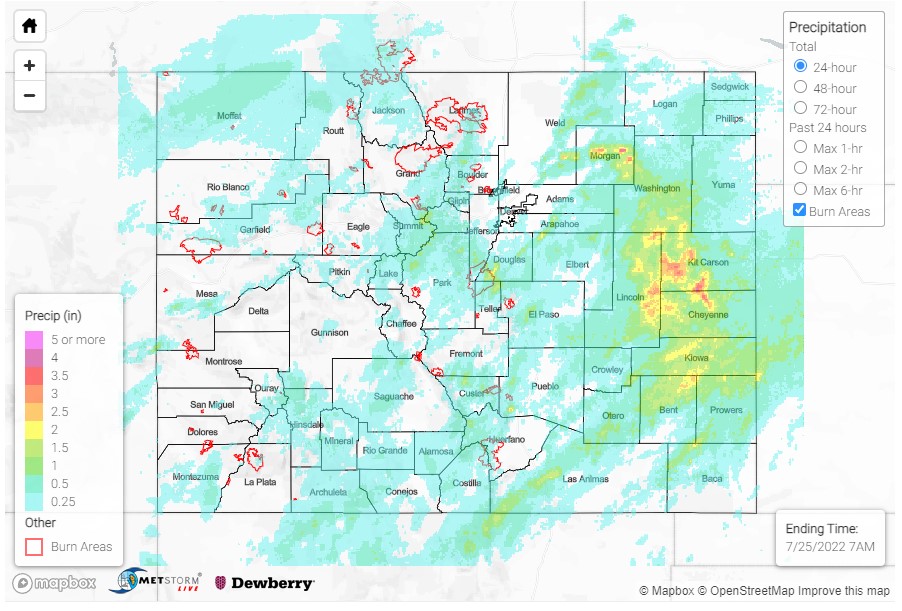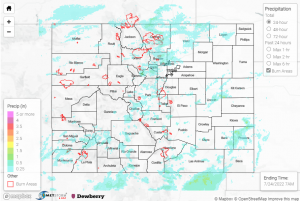Issue Date: Monday, July 25th, 2022
Issue Time: 11:00 AM MDT
Summary:
Showers and thunderstorms began early for the Grand Valley, Western Slopes, and Northern Mountains yesterday associated with an incoming low-pressure system, which acted to funnel ample monsoonal moisture into the state from the southwest. As the morning progressed, storms grew in coverage and expanded eastward into Central and San Juan Mountains, as well as the Front Range, and by afternoon widespread showers and thunderstorms covered much of the high elevations, Front Range, Urban Corridor, Palmer Ridge, and Northeast Plains. Daytime heating allowed for an increase in energy and therefore increased severe threat on the Eastern Plains, where numerous severe thunderstorm warnings were issued for large hail, high winds, and even a tornado.The eastward progression of the low resulted in drying from west to east, so by sundown most of the action was well onto the Northeast and Southeast Plains. Widespread heavy rain continued for the Southeast Plains and portions of the Raton Ridge until the very early morning hours this morning. With plenty of moisture at the surface from yesterday’s rain, many woke up to lingering foggy conditions this morning across the Eastern Plains and Urban Corridor.
There were several flood reports from yesterday’s heavy rain, including two on the Cameron Peak burn scar – which continues to remain particularly sensitive. A flash flood warning was issued yesterday afternoon for Larimer County, including the burn scar, after radar indicated thunderstorms producing heavy rain. Flooding was reported at the southern extent of the scar near Glen Haven, where the Miller Fork overtopped CR 43. Flooding was also reported near Buckhorn Mountain, where Sheep Creek overtopped CR 44H in the central portion of the burn scar. Rainfall observations are limited on the burn scar itself, but 0.94 inches was reported by the public in Glen Haven in the Big Thompson Canyon, and a CoCoRaHS report of 1.14 inches was made in Drake.
Flash flooding was also reported in Fort Morgan and Brush, along the I-76 corridor. CR28 was reported to be completely under water and washed out south of the river, and the basement of some residences also flooded. An impressive 3.50 inches of rain was reported from a Trained Spotter near Brush. Following the heavy rain, the South Platte River at Fort Morgan rapidly rose from around 200 cfs to over 500 cfs yesterday, as seen in the hydrograph below.
A Flash Flood was also reportd near Aroya, including standing water on Highway 94 between mile markers 83 and 86. Nearby, law enforcement reported visibility was down to 0 miles during the heaviest rain. Due to the rural location, there are limited reports for Aroya, though there are several observations exceeding 1.25 inches, and a few up to 1.50-1.85 in Lincoln and Kit Carson Counties.
Rainfall totals were less impressive for the Urban Corridor, though quick bursts of rain on impervious surfaces resulted in street flooding. Weather Nation shared the following video of street flooding in Northglenn. Between 0.30-0.50 was reported from CoCoRaHS observers in this area.
Look at all that rain!
Monsoonal moisture really brought the rain to Northglenn, CO today fairly quickly causing it to really pile up on the roads.#COwx #flood #monsoon pic.twitter.com/S52wu3orEw
— WeatherNation (@WeatherNation) July 25, 2022
Flash flood warnings were also issued for a portion of Mesa County in the Grand Valley, as well a small area of the Southern Front Range, and in Colorado Springs, though no flooding has been reported so far. The Grizzly Creek burn scar also had a warning issued. Rainfall totals between 0.30-0.46 were reported on the burn scar in Glenwood Canyon, but no flooding was reported. CDOT is still closing I-70 for flood warnings in Glenwood Canyon on the burn scar though.
Impressive rainfall totals were reported up and down the Urban Corridor, Palmer Ridge, and Eastern Plains even without flooding. A CoAgMet station, McClave in Southeast Plains as seen in the hyetograph below, picked up 2.54 inches in 24-hours yesterday. More impressive though, 0.53 of that came in just 5-minutes. This 5-minue total is just below the 10-year average recurrence interval precipitation value of 0.57 inches in 5-minutes for this location.
Some other notable totals across the Northeast and Southeast Plains:
- 2.47 in Brandon
- 2.28 in Eads
- 1.33-2.23 in Brush
- 2.02 in Las Animas
- 2.01 in Flagler
- 1.68 in Lamar
- 1.52 in Karval
- 1.29 in Cheyenne Wells
Some other notable totals for the Urban Corridor and Palmer Ridge:
- 1.29 in Castle Rock
- 1.28 in Hugo
- 1.18 in The Pinery
- 1.04 in Security
- 0.84 in Limon
Of note in the MetStorm Live QPE today – observers near Pagosa Springs reported between 0.90-1.54 inches of rain yesterday, however QPE below shows only 0.25-0.50 inches. This southwest portion of the state is notoriously underestimated due to it’s distance from radars. For precipitation estimates in our area, check out the map below.
Remember, if you observe flooding in your area please use the “Report a Flood” page to make a flood report when you can safely do so.





